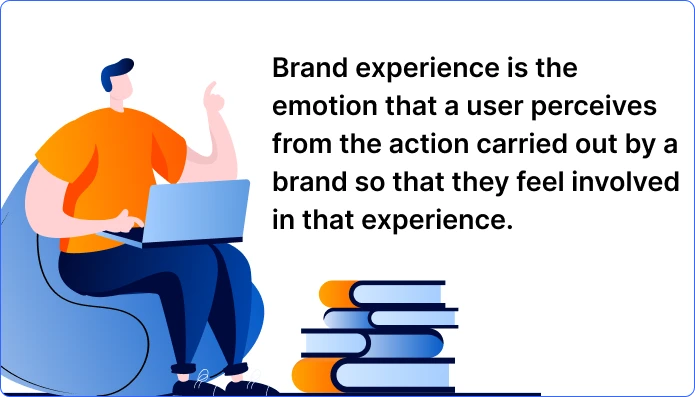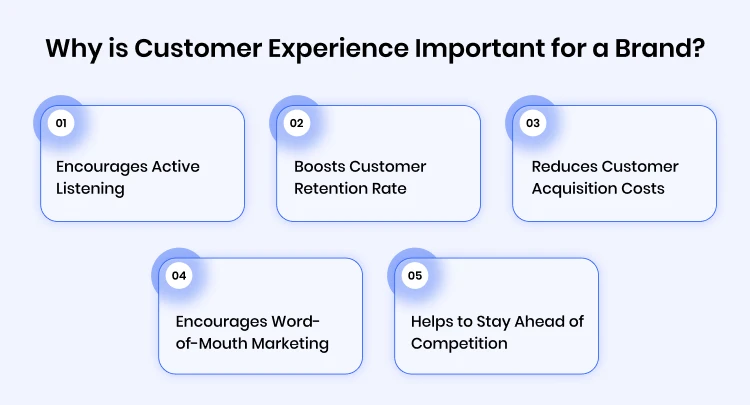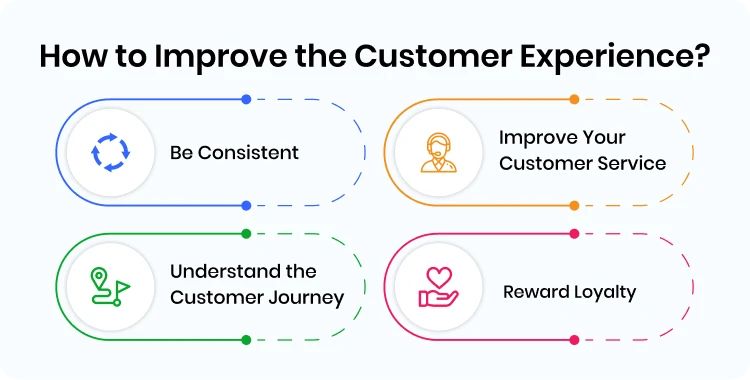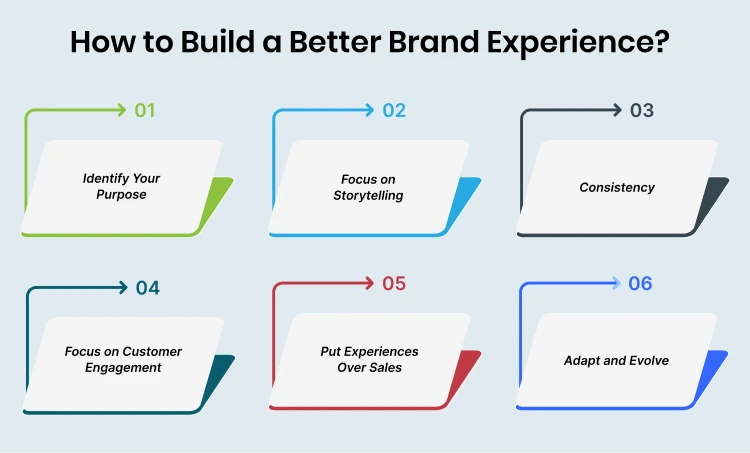Brand and Customer Experience: Exploring The Success Guide
- April 24, 2024
- 11 mins read
- Listen

Table of Content
Do you know that having a great product or service isn’t enough? Customers crave a deeper connection with the brands they choose. Studies show that 91% of consumers are more likely to make a repeat purchase after a positive customer experience. That’s where brand and customer experience come together.
This comprehensive guide dives into the powerful synergy between BX and CX, revealing how they work together to cultivate brand loyalty and drive success.
Are you ready to learn how to shape a lasting positive impression in your customers’ minds, foster loyalty, and ultimately achieve sustainable business growth?
What is Brand Experience?
Brand experience refers to all the interactions that a customer has with a brand over time. This can include the perception of the brand, the emotions it builds, and the impressions it leaves on the consumer. At its core, experience is how a person feels, thinks, and behaves about a brand.
Based on GaggleAMP findings, 81% of consumers say brand trust is a deciding factor when making a purchase decision and 46% of consumers are willing to pay more for a brand they trust.
Examples:
- Apple: It is known for its sleek design, intuitive technology, and a seamless user experience across all products and services.
- Disney: They created immersive and magical experiences in theme parks, movies, and merchandise, evoking nostalgia and happiness.
- Patagonia: Promoting sustainability and environmental activism, connecting with customers who share those values.
Remember: Brand experience is a continuous journey, not a one-time event. It requires consistent effort and attention to detail across all touchpoints.
What is Customer Experience?
Customer experience is the set of experiences that a customer has with a brand during the time in which there is a service relationship. The better the customer experience, the greater the probability of increasing customer retention, client happiness, generating new leads, increasing the average ticket, etc.
In short, it’s about how a customer feels about doing business with you. A HubSpot survey conveys that,
- 66% of customers expect companies to understand their needs.
- Customers will spend more money with companies they have a positive experience with.
- Customer-centric companies are 60% more profitable than companies that aren’t.
- 73% of consumers will switch to a competitor after just a few bad experiences.
Why is Customer Experience So Important for a Brand?
Customer experience (CX) isn’t just a buzzword. It’s the foundation for building strong brand loyalty and achieving sustainable success.
Let’s take a closer look at how CX benefits your brand:
- It Encourages Active Listening: You should always actively listen to customer needs and feedback. It plays a key role in improving your products, services, and interactions to better meet their expectations. 56% of consumers say that a business’s responses to reviews have changed their perspective on the business, as per Podia’s State of Reviews.
- It Boosts Customer Retention Rate: Positive experiences create happy customers, and happy customers are more likely to stick around. A strong customer experience strategy reduces churn and strengthens long-term customer relationships.
- It Reduces Customer Acquisition Costs: There is no doubt that acquiring new customers is expensive. You can encourage repeat business and referrals, reducing the need for constant customer acquisition efforts by providing exceptional experiences.
- Encourages Word-of-mouth Marketing: Do you know word-of-mouth marketing is invaluable? When customers have a great experience, they’re more likely to share it with friends and family, organically promoting your brand. According to research conducted by Nielsen Study, 92 percent of consumers around the world say they trust earned media, such as recommendations from friends and family, above all other forms of advertising—an increase of 18 percent since 2007.
- It Helps to Stay Ahead of Competition: CX is a key differentiator. 86% of consumers would leave a brand after as few as two poor experiences according to Emplifi. So, you should always focus on providing exceptional experiences. It sets your brand apart and helps you stay ahead of the competition.
Brand and Customer Experience Management Types
Brand and customer experience management are two sides of the same coin but with distinct focuses. Here’s a breakdown of the two and some management approaches:
Brand Experience Management
It orchestrates, plans, evaluates, and influences all interactions customers have with your brand. Basically, it influences how customers view your brand as a whole, often through indirect interactions.
Brand Experience Management Types
Here are the 5 essential pillars of Brand Experience Management:
- Brand storytelling and messaging: Every brand has a story to tell. BEM helps you define your brand’s unique narrative, voice, and values. This story should be woven into all your communication channels. It creates a consistent and compelling message that resonates with your target audience.
- Marketing campaigns: Marketing campaigns are a powerful tool for reaching new audiences and promoting your brand. BEM ensures your campaigns are aligned with your overall brand story and messaging. This creates a unified experience across all channels, from social media to email marketing.
- Public relations: There is no doubt that effective PR builds trust and credibility with your target audience. BEM helps you leverage PR strategies to generate positive media coverage and showcase your brand’s story. It’s a way that aligns with your overall brand experience goals.
- Product design and packaging: First impression is the best impression, right? The way your product looks, feels, and functions is a crucial part of the brand experience. BEM ensures your product design and packaging are not just visually appealing. Also, it reflects your brand’s personality and values. This creates a positive first impression and strengthens customer connection.
- Social media presence: In this modern world, social media platforms offer a powerful way to connect with customers and build relationships. In this case, BEM helps you develop a consistent and engaging social media strategy that reflects your brand’s voice and personality. This allows you to foster a community around your brand and encourage two-way communication with your audience.
Customer Experience Management
It’s all about enhancing all stages of a customer’s interaction with your brand, from initial recognition to post-purchase engagement. Let’s see some examples:
- Website and mobile app usability
- Customer service interactions
- Order fulfillment and returns processes
- Loyalty programs and personalization
- Feedback collection and analysis
Building Brand Loyalty by Improving the Customer Experience
Customer experience can be your secret weapon for building your brand loyalty. Ready to unlock the loyalty code? Let’s dive deep:
- Be Consistent: You should ensure a consistent brand image across all touchpoints. This includes website design, marketing messages, and customer service interactions. Consistency enriches trust and familiarity, making customers feel comfortable and valued, ultimately leading to stronger brand loyalty.
- Improve Your Customer Service: Do you know nurturing great Customer Service is the best way to build your brand loyalty? Aim to exceed expectations, and create positive interactions so that your customers feel heard and valued. Remember, happy customers are more likely to become loyal brand advocates.
- Understand the Customer Journey: Understand the complete journey of your customer. This encompasses every interaction a customer has with your brand, from initial awareness to post-purchase interactions. However, you can provide an omnichannel experience to get the best results.
- Reward Loyalty: Show appreciation for your loyal customers. Implement a loyalty program or offer exclusive rewards. These programs incentivize repeat business and make customers feel valued, strengthening their connection to your brand.
Brand Experience Vs Customer Experience: What’s the Difference?
Brand and customer experience are two essential components to creating a strong and successful business. While they may seem similar, they can be differentiated with one word: promises. Brand experience is all about making promises while customer experience is about keeping them.
Brand experience is the invitation to a journey, highlighting the exciting things you’ll encounter. Customer experience is about how smooth and enjoyable that journey is. Let’s have a look of the key differences:
1. Focusing on Perception Vs. Reality
Brand experience shapes how we see the brand, but it’s the customer experience that reveals if that perception matches reality. In short, a good brand experience creates positive expectations. A great customer experience ensures those expectations are met.
2. Using Audience Perspective
A positive customer experience varies based on ease of use, clear communication, fast response times, and personalized service. When companies prioritize customer experience, they strive to understand and meet customer needs and preferences, thereby improving customer satisfaction and retention rates.
3. Brand Experience Evolves, Customer Experience Reacts
Brand experience is like building a reputation, it takes consistent effort over time. Customer experience is about the individual moments of interaction and shaping a customer’s perception in the present.
Within the long-term brand experience, there are UI, marketing, activation, and engagement. On the other hand, the immediate customer experience includes UX, service, support, and satisfaction. Let’s take a look at all of these terms side by side:
Building the Brand Experience (Long-Term):
- UI (User Interface): This describes the general impression your brand creates across all interactions, like websites, apps, and physical stores. It’s the visual promise you make about your brand.
- Marketing: It encompasses all the communication channels you use to tell your brand story and generate interest. It’s how you create the initial positive impression.
- Activation: This involves getting potential customers to take action, like visiting your website or trying a product sample. It’s about turning interest into engagement.
- Commitment: This focuses on building a relationship with your audience by providing valuable content, experiences, and interactions. It’s about keeping the promise of a positive brand experience.
Delivering the Customer Experience (Immediate):
- UX (User Experience): This refers to the ease of use and functionality of your product or service. It’s about fulfilling the promise of a smooth and enjoyable interaction.
- Service: It encompasses the way you interact with customers before, during, and after purchase. It’s about delivering on the promise of helpful and responsive support.
- Support: This refers to the resources and assistance you provide to customers who encounter problems. It’s about keeping the promise of resolving issues effectively.
- Satisfaction: This measures how happy a customer is with their overall experience. It’s the outcome of delivering on all the promises made through brand experience.
Both brand and customer experience are important to businesses. They are different concepts that require different strategies. Companies can create a strong foundation for success and differentiate themselves from the competition by investing in brand and customer experiences.
How to Build a Better Brand Experience That Drives Customer Experience?
Building a brand experience is a strategic approach. It fuels positive customer experiences. Let’s take a look at six key steps to consider:
- Identify Your Purpose: At first, you’ll have to define your brand’s core values and the impact you want to have. This guiding light informs all your interactions and stimulates a deeper connection with customers who share your values.
- Focus on Storytelling: You can create compelling brand stories that resonate with your target audience. You know stories connect on an emotional level and it makes your brand more relatable and memorable.
- Consistency: Maintain a consistent brand image across all touchpoints, from marketing materials to customer interactions. You should consistently build trust and familiarity. It leads to a stronger brand identity and positive CX.
- Focus on Customer Engagement: Encourage active customer engagement by offering omnichannel experience. You can create opportunities for interaction through multiple channels, listen to their feedback, and respond promptly. This two-way communication builds loyalty and valuable customer insights.
- Put Experiences Over Sales: You always have to focus on creating exceptional experiences, not just pushing sales. It exceeds customer expectations by providing value and addressing their needs.
- Adapt and Evolve: The market and customer expectations are constantly evolving. Be adaptable and responsive to these changes. You need to evaluate your brand experience regularly and iterate based on customer feedback. It will play a key role in staying relevant and delivering the best possible CX.
Conclusion
Assuring the best brand and customer experience is a must for the growth of your business. You can build a better brand customer experience by adapting automation in the evolving market trends. When you combine a strong brand image with exceptional interactions at every touchpoint, you create a powerful formula for success. However, this journey doesn’t end here. It’s an ongoing process of refinement and adaptation.
Ready to get started? Integrate REVE Chat to take your brand customer experience to the next level!







